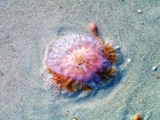Jellyfish in Coastal Georgia & South Carolina: Who is hot & who is not
WITH THE START OF SUMMER, WE THOUGHT SOUTHERNMAMAS.COM SHOULD REPOST THIS POPULAR & INFORMATIVE GUEST POST ABOUT OUR AREA’S JELLYFISH.
Below is a guest post published on SouthernMamas.com in 2011 by Tybee Island marine scientist/biologist Dr. Joe Richardson. Dr. Richardson leads Tybee Island Beach Ecology Trips . These beach walks are an excellent way to educate your kids and entertain your visitors. Read a list of activities and topics the beach ecology walk covers by clicking here. To book a family, scout, school and tour group beach walk call (912) 596-5362 or email joe@ceasurf.com . For updates regarding what Dr. Joe is finding and doing on his ecology beach walks, check out (and “like”) the “Tybee Beach Ecology Trips” FACEBOOK page by clicking here.
Jellyfish: Who’s Hot and Who’s Not
It’s not unusual to find jellyfish on our beaches, but most of the time the ones we see are harmless and will not sting you. In mid May, the most abundant jellyfish on the beach is the Cannonball Jelly. They are ball-shaped (as opposed to flat), relatively firm, and have a broad reddish-brown band wrapping around an otherwise cloudy white body. The thick structure extending out from under the bell is a system of multiple mouths. Cannonball Jellies do not have stinging tentacles hanging from the bell, so as long as you handle them on the outside of the bell or mouths, there is nothing to sting you. Only if you stick your fingers way up inside the bell could you contact any tiny tentacles, and even then they would give you only a slight tingle. So, don’t mind the Cannonball Jellies – they aren’t going to sting you.
Our common winter-time jellyfish, the Lion’s Mane Jelly, has pretty much finished its season for this year. I haven’t seen any Lion’s Mane Jellies in a few weeks now that the water has warmed up. They are round and fairly flat, and they often have some pink color. Their tentacles are fairly short and form a “hairy-looking” circle of tentacles hanging from the underside of the flat

The Lion’s Mane jellyfish is our winter-time jelly and have pretty much disappeared from our beaches now

The Sea Wasp Jellyfish will become a problem in mid July through mid August, and their sting is intense.
jellyfish. This thick circle of short tentacles supposedly resembles the hairy mane around the neck of a male lion. Lion’s Mane Jellies produce a very mild sting; and I personally don’t consider it a “sting” but more of an irritation.
As the water warms into the summer, we will start seeing Moon Jellies. They are very flat, round and clear, and usually have 4 horseshoe shaped structures visible near the center. Moon Jellies have a fringe of short tentacles extending from the very outer edge of their flat body. I’ve seen Moon Jellies on Tybee Island as large as a dinner plate. Moon Jelly tentacles produce a mild sting. It is not really painful, but you know that you have been stung; but it’s not likely going to cause you much discomfort.
It’s during late July and the first couple of weeks of August, on average, that we reach the peak of the Sea Wasp season on Tybee. The Sea Wasp jellyfish are our “bad guys” around here. (We rarely have trouble from floating, blue Portugese Man of War on Tybee, especially compared to some beaches in Florida). But the Sea Wasp jellyfish in late summer do cause us problems. They are clear, and we can’t see them in the water. Although their body is fairly small (2-3 inches), they produce a number of long thin tentacles that extend from 4 hand-like structures that hang from the bottom of their box-shaped body. Even when they are dead and washed up on the beach, Sea Wasp tentacles can still sting. Their sting is an instant intense burning sting, and these stings will make you want to get out of the water and seek some relief. Although the intense pain subsides after a few minutes, the stung area will still hurt a while, and usually some red marks will appear where the tentacles contacted your skin. For me, the stung areas itch for a few days later also.
The above is a guest post by Tybee Island marine scientist/biologist Dr. Joe Richardson, who leads Tybee Island Beach Ecology Trips . These beach walks are an excellent way to educate your kids and entertain your visitors.












































